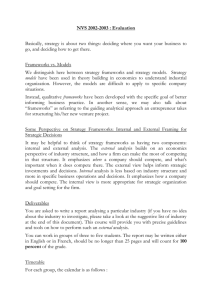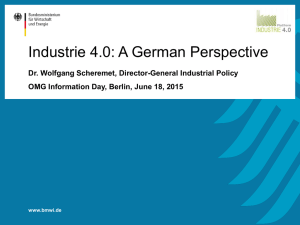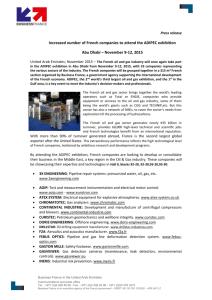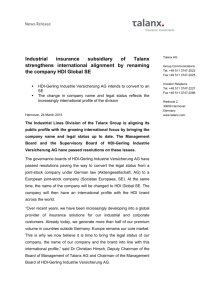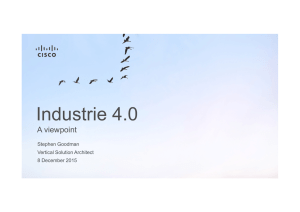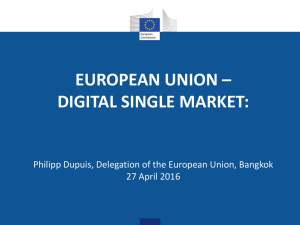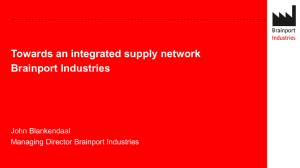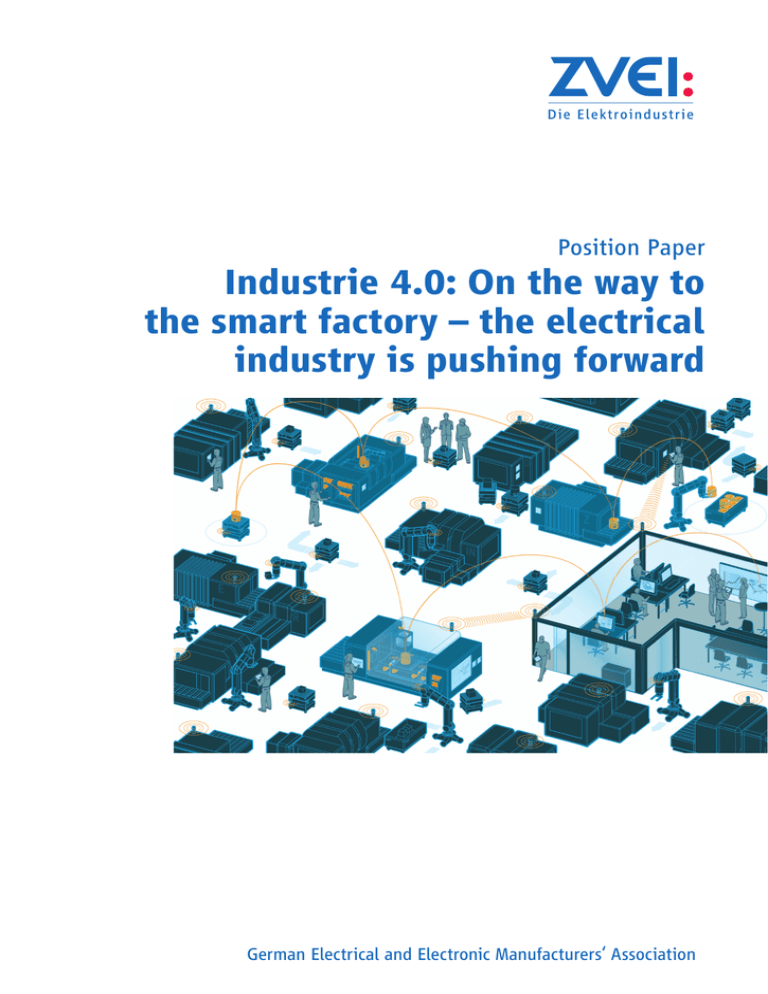
Position Paper
Industrie 4.0: On the way to
the smart factory – the electrical
industry is pushing forward
German Electrical and Electronic Manufacturers‘ Association
Impressum
Position Paper
Industrie 4.0: On the way to the smart factory –
the electrical industry is pushing forward
Published by:
ZVEI - German Electrical and
Electronic Manufacturers‘ Association
ZVEI Automation Division
Lyoner Strasse 9
60528 Frankfurt am Main, Germany
Responsible:
Gunther Koschnick
Telephone: +49 69 6302-318
E-mail: automation@zvei.org
www.zvei.org
January 2016
While every care has been taken to ensure the accuracy of
this document, ZVEI assumes no liability for the content.
All rights reserved. This applies in particular to the
storage, reproduction, distribution and translation of this
publication.
Contents
1. What is Industrie 4.0?
4
2. Industrie 4.0: ZVEI leads the electrical industry
5
3. Making Industrie 4.0 feasible
(and understandable)
6
4. Industrie 4.0 has new players
7
5. Networking starts in people‘s heads
7
6. Global standards for Industrie 4.0
8
7. Communication infrastructure 4.0 is required! 9
Broadband expansion
9
Radio links
9
8. Industrie 4.0 – But reliably!
10
Safety concepts, architectures and standards
10
Safety & Security
11
Strengthening trusted IT infrastructures in Europe
11
9. What must be done –
Make Industrie 4.0 possible
12
1. What is Industrie 4.0?
The impact of digitization is already very clear
to see in many industries: prominent examples include streaming services in the music
industry, the taxi service Uber, 3D printing
and the digitization of the media industry.
Many of these examples are disruptive technologies that shake up traditional business
models and can even make them obsolete.
Disruptive technologies result in major changes in value creation.
The advancing digitization and networking
of production is also changing value chains
in industry – this transformation is known in
Germany as Industrie 4.0. The term “Industrie
4.0” stands for the interaction of three factors: the digitization and integration of vertical and horizontal value chains, the digitization of products and service offerings, and
new digital business models. This results in
new solutions being created for the Internet
of Things, Services and People. Figure 1 summarizes these three aspects of Industrie 4.0.
The digitization and integration of the value
chains means that data from various phases
of the product life cycle is available across
companies – from the quotation process
through to production and on-site service. All
companies in the value creation network can
thus access the data they need at any time.
For example, mechanical engineers receive
the component supplier data that is relevant
to them, and users integrate the mechanical
engineers’ digital construction data into the
design of their factory buildings in advance.
This results in increased efficiency, which
benefits all those involved.
For this purpose, however, information regarding products and services must be available
in digital format. The digitization of products
and services means the complete virtual
description of services and products.
However, end-to-end digitization also facilitates completely new digital business models.
Services and offerings are created that bring
the user decisive advantages using data that
is, for instance, in the cloud: examples are
more efficient and predictive maintenance of
equipment.
Fig. 1: The three central aspects of Industrie 4.0
Source: ZVEI, based on PwC
4
2. Industrie 4.0:
ZVEI leads the electrical industry
The German electrical industry plays a key role
when it comes to implementing smart factories in the manufacturing and smart plants in
processing industry. Its know-how, equipment
and systems are the enabler for the transition
to digital production that transcends geographical boundaries.
(Management Team Industrie 4.0) are working on architecture models and the associated standards. As Figure 2 shows, this work
is carried out in the Plattform Industrie 4.0
in close cooperation with many different parties, including the mechanical engineering
and ICT sectors.
ZVEI member companies undoubtedly have
the knowledge of manufacturing and business
processes in the manufacturing and process
industry as well as the expertise to produce
Industrie 4.0 technologies. Automation forms
the interface between machines and production in the Internet of Things, Services and
People. It both equips and uses Industrie 4.0.
For this reason, a holistic understanding of
Industrie 4.0 developed here first.
ZVEI has worked in cooperation with the VDI/
VDE-Society for Measurement and Automatic
Control (GMA) to make a crucial contribution
to the Plattform Industrie 4.0 using the Reference Architecture Model Industrie 4.0 (RAMI
4.0) and Industrie 4.0 component (see details
in Section 6).
This is the basis on which member companies in the ZVEI-Führungskreis Industrie 4.0
The most important point is for companies to
implement this now. Digitization represents
both an opportunity and a challenge for every
company – whether it is a corporate group, a
mid-sized enterprise or even a small business.
Fig. 2: ZVEI-Führungskreis Industrie 4.0 supports the Plattform Industrie 4.0
Source: ZVEI
5
Firstly, new – sometimes disruptive – opportunities arise to become established in markets
and new fields of business. Secondly, there is
a risk that companies may miss the boat when
it comes to new trends. This jeopardizes the
future viability of companies, particularly if
they are unaware of these challenges or simply ignore them.
and medium-sized companies that play such
an important role in the German economy, as
well as highlighting the far-reaching implications for our sector and markets.
RAMI 4.0 and the Industrie 4.0 component
form the basis for Industrie 4.0. Now the
important point is to find reliable approaches
for implementation.
With this in mind, ZVEI is introducing the
topic of Industrie 4.0 in particular to the small
3. Making Industrie 4.0 feasible
(and understandable)
It is not sufficient to describe Industrie 4.0 as
models. The benefits of the new technology
must be clearly demonstrated if the vision of
fully networked and digitized production is
to become reality. For this reason, the ZVEI
use cases focus on typical problems that confront users of automation technology in their
production facilities and which can be solved
with Industrie 4.0 technologies. This clearly
illustrates the added value and benefits of
these solutions in an actual production environment. Furthermore, the ZVEI use cases also
allow Industrie 4.0 to develop along standardized lines using the Reference Architecture
Model Industrie 4.0 and the Industrie 4.0
component, and it also allows the models
themselves to develop.
When doing this, ZVEI works closely with
companies across the spectrum of industrial
production – including the process industry,
mechanical engineering and the automobile
sector – and creates demonstrators for this.
6
The policy can help to establish Industrie 4.0
on a broad front and create orientation for
companies. When it comes to the use cases,
the ZVEI progresses the project with the
Fraunhofer Institute for Manufacturing Engineering and Automation (IPA) and implements
the theoretical work of the Industrie 4.0 platform practically. Full, academically led implementation of the use cases into Industrie 4.0
solutions along RAMI 4.0 can be supported
by selective research funding. When granting
funding, it is essential that Government-funded projects should take the application and
work with RAMI 4.0 into account.
4. Industrie 4.0 has new players
Integration of value-adding chains and digitization of products require more IT expertise in automation: companies develop their
software expertise and new players from the
software sector dare to enter the factory and
equipment environment with their business
ideas. This creates new partnerships but also
new competitors.
ZVEI encourages the exchange between established companies in the electrical industry
and start-ups from the software sector. Here
the Association is the platform where automation companies with their high level of expertise in the sector come together with suppliers
of digital services and solutions from the
software sector. At the same time, established companies from the electrical industry
have what it takes to become suppliers of new,
smart services and to penetrate further into
the ICT sector.
Industry-orientated start-ups need special
support in Germany. ZVEI is demanding that
demonstration centers and projects, in particular, need to receive greater state support as
a suitable test environment for start-ups and
SMEs. Improved tax framework conditions for
young companies and venture capital investors are also required.
5. Networking starts in people‘s heads
Industrie 4.0 needs competent employees:
Industrie 4.0 is not about “men or machines”
but it is actually about “men with machines”.
It is men who orchestrate Industrie 4.0. They
must interpret information correctly and make
decisions.
Employees must therefore be qualified for
future tasks. The work in the smart factory
of the future will place greater demands on
the individual skills of employees in relation
to complexity, and abstraction and problemsolving capabilities. Apart from these new
demands, Industrie 4.0 also offers tremendous opportunities for enriching the quality
of work, reducing the physical burden of hard
work activities, giving more individual responsibility and therefore offering the employee
increasing self-fulfillment.
The electrical professions that ZVEI has codeveloped are, even now, system oriented
and designed for cross-sector cooperation.
Flexible training regimes permit the necessary adaptation to business requirements and
7
technical development and therefore also to
Industrie 4.0. Continuous further training
puts employees in a position to keep pace with
rapid technical development. Therefore, in the
coming years the focus must be on further
training. Software expertise and the ability
to model complex industrial processes and
implement them in digital systems are becoming increasingly important for engineering
degree courses at universities and colleges.
For this reason, the amount of IT taught must
not be reduced in engineering degrees.
In order to counteract the lack of skilled labor
in Germany, ZVEI sees three areas where
policymakers must act:
•The early nurturing of young talent in what
are known in German as the MINT subjects,
i.e. math, information technology, natural
sciences and technology, by teaching math
and natural sciences at schools, which arouses pupils‘ interest in technology at an early
stage,
•The comprehensive development of childcare in order to make it easier to combine
work and family commitments,
res, further simplification of the recognition
of foreign school, university and vocational
qualifications.
•The rapid integration of qualified immigrants. These include, among other measu-
6. Global standards for Industrie 4.0
It is intended that, in future, workpieces and
machines will communicate between each
other autonomously within and between
smart factories. To do this, the workpiece
and production system must be networked to
each other intelligently. This only operates via
standards that describe the communication
between the components. Furthermore, the
smart factory is part of a global value creation
network: it therefore needs global standards,
preferably from the internationally recognized
standards organizations.
Parallel to this and initially, technical specifications, i.e. not fully consensus based and
therefore documents that can be published
more quickly such as the DIN SPEC or VDE
application rules, of special user groups
(e.g. the electrical industry) become guidelines for the development of a common standard. This also includes radio links according
to IEEE standards, product characteristic
descriptions such as offered by eCl@ss, or
machine communication in accordance with
standards such as OPC UA (transferred into
standards, DIN EN 62541).
Apart from consensus-based standardization,
the Association also supports the use of specifications. They can frequently be tried out and
applied on the market. The German electrical
industry has produced the reference architecture model RAMI 4.0 and the Industrie 4.0
component with the decisive involvement
Fig. 3: Reference Architecture Model Industrie 4.0 (RAMI 4.0)
Source: ZVEI, Plattform Industrie 4.0
8
of ZVEI experts. The architecture model is a
type of three-dimensional map for Industrie
4.0 solutions. The model provides guidance in
respect of existing standards and gaps in standardization and therefore creates a shared
understanding.
The Industrie 4.0 component is a model for
objects in the Industrie 4.0 production environment. It describes the association of a physical object to the digital world via a virtual
representation of the administration shell.
The model therefore acts as a template so
that hardware and software components with
Industrie 4.0 capability can be developed.
Both models are now transposed into a DIN
SPEC and then incorporated into international
standardization. The Association also describes practical fields of application with the
help of Industrie 4.0 application scenarios,
the so-called ZVEI use cases, and calculates
the standardization requirement via RAMI 4.0.
Currently, the ZVEI-Führungskreis Industrie
4.0 is working on standardized semantics and
standardized descriptions of characteristics in
order to make it possible for machines to communicate across domains.
The current statutory regulations are adequate and new regulatory interventions are
not required. However, political support can
be provided by putting forward the case for
the use of international standards and specifications in other regions of the world as well.
7. Communication infrastructure 4.0
is required!
In order to create a communications infrastructure for Industrie 4.0, broadband expansion and the use of wireless radio links in production are required.
Broadband expansion
ZVEI is demanding a rethink in the perspectives for German policy in the promotion of
broadband. The Association is speaking out in
favor of simplified framework conditions and
concentration on a sustainable, comprehensive expansion using fiber optics.
It is the ZVEI‘s view that Germany‘s international competitiveness over the next 10 to 15
years depends crucially on the expansion of
the broadband infrastructure. The aim must
be to occupy one of the top positions among
industrial nations when it comes to broadband services. Resources and investment must
therefore concentrate on rolling out the net-
9
work so that it also has adequate reserves for
the coming decades.
ZVEI is demanding that the government
expands the short-term broadband objectives
to include objectives with perspectives for the
period up to 2030. By then companies and
private households require comprehensive
access to broadband in the gigabit range.
Here, consideration must not only be given to
download rates. Higher upload speeds must
be obtained and better quality connections
must be ensured, especially if Industrie 4.0 is
to be successfully implemented.
Radio links
The communication capability of all components, workpieces and machines right down to
the lowest production level is the prerequisite
for highly dynamic and flexible Industrie 4.0
production. Only wireless communication per-
mits mass networking of all production units.
It therefore takes on a key role in the implementation of Industrie 4.0.
Industrie 4.0 therefore makes increasing use
of radio networking techniques in the 2.4
GHz band, as this will allow the cost-efficient
expansion of networks, which require less
maintenance and are more flexible in an
industrial environment. “Robust” wireless
technologies that meet real-time requirements are required for this. These are wireless
technologies that allow radio transmissions
at a defined time (determinism) and with fast
response times (minimal delay) in production.
As an example, in discrete manufacturing,
for instance, it involves a few milliseconds.
Robustness is required, as the availability of
the radio link and the management of various
applications simultaneously must be ensured.
For over ten years, ZVEI has been promoting
the development of these wireless technologies in industrial applications. In doing this
the Association is representing the interests of
the automation specialists in standardization
and frequency policy. Since 2009 the Associ-
ation has been intensively engaged in European standardization work (ETSI ERM TG11).
The aim is to guarantee that the requirements of industrial automation are taken into
account in the ETSI standards.
The current developments of European standardization considerably restrict the use of
innovation potential of industrial radio applications. In order to safeguard Europe as a production base, it must also be possible in the
future to deploy industrial radio applications
in the 2.4 GHz spectrum that is used globally.
From an industrial point of view, there is an
appropriate solution concept: the 10-mW factory. It has been examined as an example and
confirmed by the German Federal Network
Agency. The concept needs to be accepted
throughout the EU and must be asserted politically.
In the long term, an exclusive frequency range
of at least 80 MHz in the range 1.4 – 6 GHz
is required for wireless applications in industrial environments. The ZVEI is working for
this subject to be tabled at the next World
Radiocommunication Conference (WRC).
8. Industrie 4.0 – But reliably!
The increasing networking of things and systems in the Internet of Things, services and
people, which in the past have primarily
been seen in the consumer sector and in the
commercial and administrative areas of companies, is entering the production halls with
Industrie 4.0. In the smart factory of the
future objects – workpieces, tools, machines,
etc. – will communicate with each other and
the person who “orchestrates” them. This
means that many different players generate
large quantities of data within the factories,
some of which is time critical, and also information across factory limits. This changes the
10
role of IT security: additions implemented retrospectively are no longer sufficient. IT security must be an integral part of business processes, systems and products right from the
start. Cross-company networking cannot be
achieved without (tiered) safeguards.
Safety concepts, architectures
and standards
ZVEI has already started to answer today‘s
urgent questions about cyber security with
active involvement in the VDI/VDE directive
2182, which is currently being incorporated
in the international Standard IEC 62443, and
involvement in the NAMUR recommendation
(NE) 153. The description does not only cover
the requirements for current systems and
automation technology: it also includes clear
procedures for manufacturers, operators and
integrators. This work forms the basis for the
Industrie 4.0 security concepts that are to be
developed as part of an evolutionary procedure.
With the Industrie 4.0 component the Association has developed, together with its partners,
a model for the smart factory of the future,
which allows generators of data to exchange
data with partners – indirectly and controlled
– via the administration shell, in other words
a “digital data rucksack”. Further security
concepts, architectures and standards must
be developed on the basis of this so that, in
the future too, the confidentiality, integrity,
authenticity and, in particular, availability
can be ensured. It is clear that the data must
be and remain usable. This is because new,
smart business models in automation, which
are decisive in global competition, are based
on data.
It is inevitable that a hybrid path must be
adopted to overcome the security problems.
Because of the long life cycles of industrial
production systems, both retrofittable solutions for Industrie 4.0 integration of existing
machines and systems as well as “Security-byDesign” concepts for new products and systems are developed. What is important is to
establish a consensus in respect of the safety
architecture throughout the entire value
chain.
11
Safety & Security
Security consists of the dimensions operational safety and protection against (targeted) manipulation. There is no doubt that
the interaction of both dimensions is critical
for the success of Industrie 4.0. For this, the
interactions between the two dimensions must
be investigated and formalized in an initial
step. For instance, an important point here is
the extent to which cryptographic procedures
influence time-critical functions of functional security or vice-versa, or whether certain
security-critical functions of a partial system
provide vulnerabilities for cyber-attacks.
Strengthening trusted IT
infrastructures in Europe
Highly trusted technical solutions can become
a feature that distinguishes Germany and
Europe. Even now, many highly specialized
providers of solutions for cyber security have
their headquarters in Germany. The establishment of trusted IT infrastructures as a contribution to the digital sovereignty of Europe
must be progressed systematically. However,
this must be supported by appropriate political initiatives. The aim is to strengthen the
security competence and trustworthiness of
German and European companies as a decisive competitive factor. This unique opportunity for Europe must finally be recognized and
grasped.
9. What must be done –
Make Industrie 4.0 possible
1. Make Industrie 4.0 feasible (and
understandable)
4. Industrie 4.0 needs global standards
Further state support for case studies right
up to the implementation of demonstrators
is required to develop Industrie 4.0 solutions
along RAMI 4.0. State funding should only be
granted expressly for the application of and
work with RAMI 4.0.
The current statutory regulations are adequate and new regulatory interventions are
not required. However, political support can
be provided by putting forward the case for
the use of international standards and specifications in other regions of the world as well.
2. Industrie 4.0 has new players
5. Communication infrastructure 4.0 is
required
ZVEI is demanding that demonstration centers
and projects, in particular, need to receive
greater state support as a suitable test environment for start-ups and SMEs. Improved tax
framework conditions for young companies
and venture capital investors are also conceivable.
3. Networking starts in people‘s heads
Continuous further training puts employees in
a position to keep pace with rapid technical
development. Therefore, in the coming years
the focus must be on further training. Parallel
to this, measures must be taken to counteract
the lack of skilled labor in Germany. ZVEI sees
three areas where policymakers must act:
•The early nurturing of young talent in what
are known in German as the MINT subjects,
i.e. math, information technology, natural
sciences and technology, by teaching math
and natural sciences at schools, which arouses pupils‘ interest in technology at an early
stage,
•The comprehensive development of childcare in order to make it easier to combine
work and family commitments,
•The integration of qualified immigrants.
These include, among other measures,
further simplification of the recognition of
foreign school, university and vocational
qualifications.
12
•Broadband expansion
ZVEI is demanding that the government
expands the short-term broadband objectives to include objectives with perspectives for the period up to 2030. By then
companies and private households require
comprehensive access to broadband in the
gigabit range. Here, consideration must not
only be given to download rates. Higher
upload speeds must be obtained and better
quality connections must be ensured, especially if Industrie 4.0 is to be successfully
implemented.
•Radio links
The current developments of European standardization considerably restrict the use
of innovation potential of industrial radio
applications in Europe. In order to safeguard
Europe as a production base, it must also be
possible in the future to deploy industrial
radio applications in the 2.4 GHz spectrum
that is used globally. From an industrial
point of view, there is an appropriate solution concept: the 10-mW factory. The concept needs to be accepted throughout the
EU and must be asserted politically. In the
long term, an exclusive frequency range of
at least 80 MHz in the range 1.4 – 6 GHz is
required for wireless applications in industrial environments.
6. Industrie 4.0 – But reliably
•Today German industry must ask itself how
it can design Industrie 4.0 securely and
drive it forward. It needs both retrofittable solutions and Security-by-Design to be
developed
•Strengthening trusted
IT infrastructures in Europe
The development of digital sovereignty
must be pursued vigorously throughout
Europe. This unique opportunity for Europe
must finally be recognized and grasped.
13
Further information on Industrie 4.0:
Contact:
Gunther Koschnick
Managing director
ZVEI Automation Division
Telephone: +49 69 6302-318
E-mail: koschnick@zvei.org
•ZVEI provides a short and concise explanation of the Reference Architecture Model
Industrie (RAMI) 4.0 and the Industrie 4.0
component. You can find all information that
the ZVEI provides about Industrie 4.0 here:
www.zvei.org/Themen/Industrie40
•To the ZVEI image film
“Industrie 4.0: Integrated Industry reaches
the next level“
youtu.be/ccB6e18VwsQ
14
Telephone: +49 69 6302-0
Fax: +49 69 6302-317
E-Mail: zvei@zvei.org
Source cover photo: ZVEI
ZVEI - German Electrical and
Electronic Manufacturers‘ Association
Lyoner Strasse 9
60528 Frankfurt am Main, Germany

